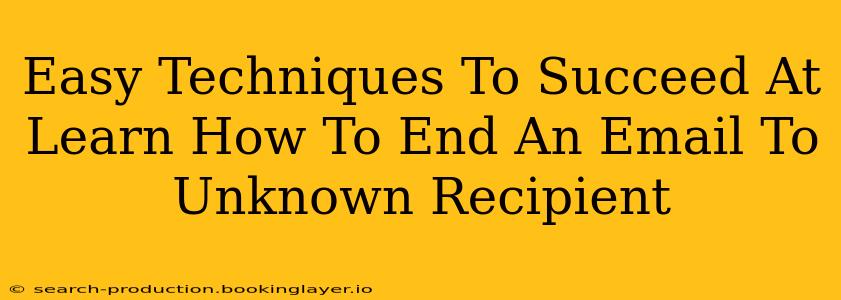Ending an email to an unknown recipient can feel tricky. You want to be professional, memorable, and get a response. This guide provides easy techniques to master the art of the closing, boosting your chances of success in your communication.
Understanding Your Audience: The Key to a Successful Closing
Before diving into specific closings, it's crucial to understand who you're emailing. Are you contacting a potential client, a prospective employer, or someone you've connected with through networking? Your closing should reflect this. A casual closing for a potential client could be detrimental, while a formal closing for a networking contact might appear stiff. Consider the context and adapt accordingly.
Analyzing the Recipient's Personality and Tone:
Reading previous communications (if any) can offer valuable insights into the recipient's communication style. Do they use formal language or a more casual tone? Mimicking their style in your closing can help build rapport. However, avoid mimicking if their communication style seems unprofessional. Instead, opt for a neutral and professional approach.
Effective Closing Lines for Unknown Recipients
Here are some effective closing lines suitable for various scenarios when emailing unknown recipients:
Formal Closings:
- "Sincerely," - This classic closing is always appropriate for formal communications. It conveys professionalism and respect.
- "Respectfully," - This option is suitable when addressing someone in a position of authority. It expresses deference and politeness.
- "Regards," - A slightly less formal yet still professional option that works well in most business contexts.
Semi-Formal Closings:
- "Kind regards," - This option strikes a balance between formality and warmth, making it suitable for many professional situations.
- "Best regards," - Similar to "Kind regards," but slightly more concise.
- "Cordially," - This closing conveys friendliness and professionalism without being overly familiar.
When to Avoid Informal Closings:
Avoid informal closings like "Cheers," "Best," or "Talk soon" when emailing an unknown recipient, especially in a professional context. These closings can appear unprofessional and may even damage your credibility.
Beyond the Closing Line: Optimizing Your Email for Success
The closing is just one part of the email. Other elements significantly impact your chances of receiving a response:
A Compelling Subject Line:
Your subject line is the first impression. Make it clear, concise, and compelling to entice the recipient to open your email. Avoid generic subject lines that might get lost in their inbox.
A Concise and Well-Structured Email Body:
Keep your email brief and focused, highlighting the key points efficiently. Use bullet points or numbered lists to improve readability. Always proofread your email carefully before sending to avoid any grammatical errors or typos.
A Clear Call to Action:
What do you want the recipient to do after reading your email? Make your desired action crystal clear – whether it's scheduling a meeting, reviewing your resume, or visiting your website.
Monitoring and Following Up:
After sending your email, monitor your inbox for a response. If you haven't heard back within a reasonable timeframe (e.g., a week), a polite follow-up email is acceptable. Avoid being overly persistent; respect the recipient's time and schedule.
By following these techniques and paying attention to the overall context of your communication, you can significantly improve your chances of success when emailing unknown recipients. Remember, a well-crafted email is a crucial first step in building professional relationships.

